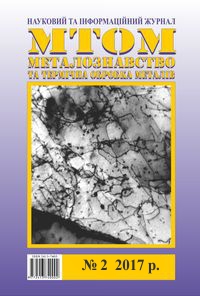Fracture mechanics of the constructional building steel
Keywords:
constructional steel, steel construction, fracture photomicrograph, brittle fractureAbstract
Formulation of the problem. Complex alloyed high-strength bainitic steel 14Х2ГМР and normal quality ВСт3сп were chosen for this study. Steel ВСт3сп were chosen due to the fact that it is currently the most widely used material in the construction. By the use heat treatment and thermomechanical treatment, we can increase the uniformity of the structure and mechanical characteristics. The low content of alloying elements (up to 4 % in total) provides satisfactory weldability and the relatively low cost of steel construction. Therefore, the use of the local high competitive rolled metal in the local construction market, is economically viable, as well as reduce the dependence of industry on foreign countries − the importers of metal. Presented results provides generalized overview of the most common fracture mechanisms for the low-carbon and low-alloyed constructional steels. The influence of the structure parameters (type, shape, size, distribution of second phase particles, inclusions and grain size) on the nucleation and propagation of the cracks were studied. Objective. Understanding the nature of the processes and conditions for the structural element formation on the fracture surface give us opportunity for reliable inspection breaks and fracture of the metal constructions elements. Conclusions. Were identified and described the most common fractures based on the deformation and fracture processes.
References
Иванова В. С. Разрушение металлов : монография / В. С. Иванова. – Москва : Металлургия, 1979. – 168 с. − Режим доступа: http://www.twirpx.com/file/1043950/
Структурная теория упрочнения конструкционных сталей и других материалов : монография / [В. И. Большаков, Л. И. Тушинский]. − Днепропетровск : Издательство «Свидлер А. Л.», 2010. – 484 с. − Режим доступа: http://ciu.nstu.ru/kaf/mm/nauchnaya_deyatelnost/monograflist_new
Растровая электронная микроскопия. Разрушение : справочное издание / Л. Энгело, Г. Клингеле. – Москва : Металлургия, 1986. – 232 с. − Режим доступа: http://www.exlit.ru/bb431839962.html
Котречко С. А. Параметры микроструктуры, контролирующие хрупкую прочность малоуглеродистых сталей со структурой мартенсита отпуска / С. А. Котречко, Ю. Я. Мешков, Р. В. Телевич // Металлофизика и новейшие технологии. – 2004. – 26, № 4. – С. 435−456. − Режим доступа: http://mfint.imp.kiev.ua/ru/browse.html
Механическая стабильность металлов и сплавов : монография /
[Ю. Я Мешков, С. А. Котречко, И. В. Шиян]. – Киев : Наукова думка, 2014. – 277 с. – Режим доступа: http://www.nbuv.gov.ua/sites/default/files/eif0000053.pdf
Published
Issue
Section
License
Authors that are published in this journal agree to follow the conditions:
Authors reserve the right to the authorship of his work and cede the right to the journal of first publication of this work on conditions of the license under the Creative Commons Attribution License, which allows others to distribute it freely with the obligatory reference to the author of the original work and the first publication of the work in this journal.

